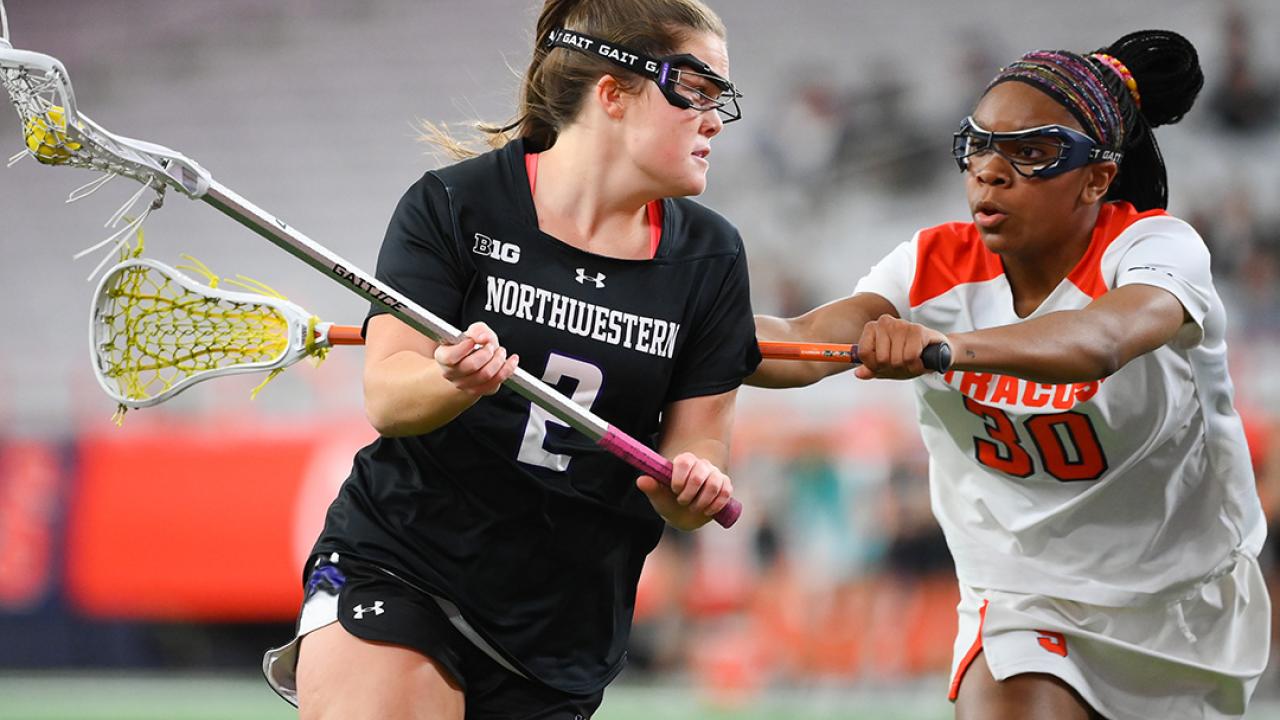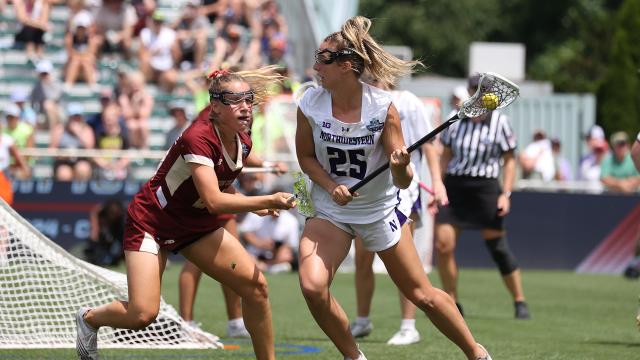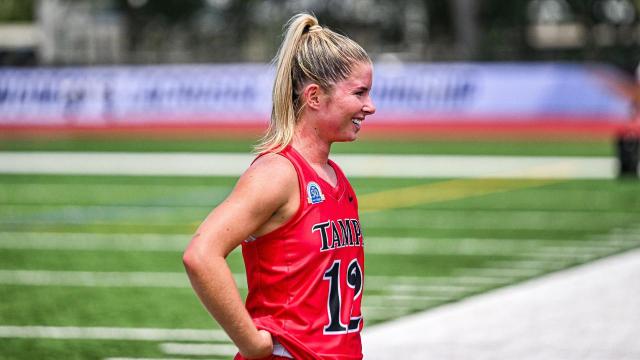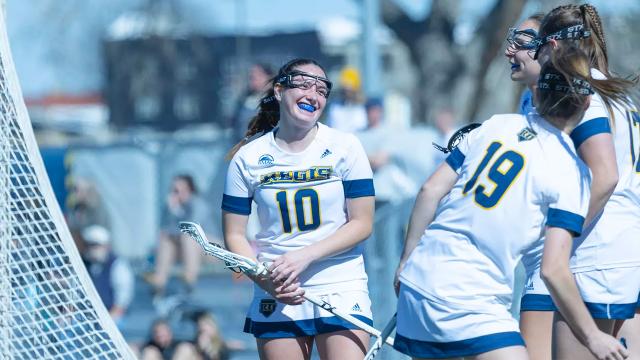
Grading the Committee: Teams Get Rewarded for Big Wins
Pile up the wins and get rewarded.
That was the simple message from the NCAA Selection Committee after it revealed the 29-team field for the Division I Women’s Lacrosse Championship.
This held true for teams that were seeded, as well as those that were the final at-large teams included in the field.
“I think there is a very clear process to evaluating teams all year long,” said Bonnie Rosen, Temple head coach and NCAA committee chair. “Every week, things were looked at with fresh eyes, right up until this morning and this afternoon. We try not to take a subjective view of teams.”
That process included the obvious of seeing RPI and strength of schedules, but when it came down to the minute details, the amount of significant wins ruled the day.
This was was most apparent when deciding the top five seeds — Northwestern, Syracuse, Boston College, North Carolina and Denver. Rosen cited wins against RPI top 10 and RPI top 20 teams as differentiating factors.
That trend didn’t apply to the bottom of the seeds, as James Madison had more top-20 wins (five) than Florida (four), yet the Gators were seeded 6th and the Dukes 7th. The same holds true for Loyola at No. 8, but we’ll cover that later.
THE DENVER CONUNDRUM
The Denver Pioneers went 19-0. They went out and beat Boston College and Maryland. What else are they supposed to do?
“It’s one of the more interesting conversations,” Rosen said. “[Denver] has had a spectacular regular season; it’s really impressive to go 19-0. On face value, when we sat down with the numbers, UNC’s number of wins against the top 10 group of teams was just more significant.”
When comparing the top five teams, one particular thing stood out: UNC, BC, Syracuse and Northwestern all boasted a SOS of 5 or better, while Denver was 19th.
“It’s hard to compare them,” Rosen said. “[Teams] can’t control their full schedule. The resume of SOS wins was what weighed heavier than the win-loss record. We go with the formula that we have in front of us and have to make the calls.”
In the end, North Carolina getting a win over Syracuse in the ACC tournament, its fourth against fellow seeded teams, is likely what tipped the Tar Heels past the Pioneers.
SEEDING QUIBBLES
It may not seem like a huge deal who is a 6 or a 7 seed, but the committee elected to swap James Madison and Florida in this regard. Their profiles were so similar that the committee went into the secondary criteria of late-season performance and non-conference RPI.
“It was a tough call along the way,” said Rosen, whose Temple team faced both JMU and Florida in conference play. “We felt like we were being consistent with how we looked at it … in the end, it was a little bit RPI shift, a little bit conference championship.”
As for the No. 8 seed, Loyola was a mild surprise. The Greyhounds were 8th in the RPI, trailed closely by Maryland in 9th, but lacked the same quality wins that the Terrapins had. In this case, the committee deviated slightly from its significant wins formula for the first seven seeds and looked at a different criterion: losses.
Maryland held a win over seeded Florida, a team that Loyola lost against. Nevertheless, a team that Loyola beat that Maryland lost to, Penn State, is what gave the Greyhounds the nod. This in spite of Maryland having five top 20 wins, including one over a top 10 team, to Loyola’s four, none of which were against top 10 competition.
“Honestly, there was a lot of discussion around this especially because of the hosting piece,” Rosen said. “It came down to, while there were no bad losses, Loyola had no losses out of the top 10, while Maryland had a loss out of the top 20 (Penn State), and the late season run that Loyola had.”
EASY BUBBLE DECISIONS
It appeared as Sunday night came about that the only question on the bubble was for the 14th and final at-large spot. In the end, the committee gave the nod to Penn State on the strength of the aforementioned win against Maryland. The Nittany Lions now hold the distinction as having the highest RPI for an at-large team at 32. The committee applied the same set of criteria to the bubble discussion as the seeded teams.
“We really made sure to look at the bracket and make sure we were evaluating not just the RPI, but strong wins,” Rosen said. “We were comparing them to other teams that might be ahead in RPI, ultimately a lot of decisions came down to lacking in top 20 wins or having significant losses.”
HISTORY SETTERS
The 2023 bracket sees some new faces in Army and Marquette. Both teams garnered at-large bids and their excitement was evident on the ESPNU broadcast. Congratulations to the Black Knights and Golden Eagles.
Moreover, the Atlantic 10 saw two of its own make the NCAA tournament for the second straight year as Richmond and UMass were selected. Before 2022, the A-10 hadn’t been a multi-bid league since 1984.
THE FAVORITE
It may be too obvious to pick Northwestern, but how do you pick against the Wildcats? A one-goal, opening season loss to Syracuse is all that separates them from a perfect season thus far. Northwestern has a staggering 12 wins over NCAA tournament teams. It already beat the Nos. 3 and 4 seeds, as well as Maryland (twice), Stony Brook, Notre Dame, Michigan (twice), Marquette, Johns Hopkins, Albany and Penn State.
THE DARK HORSE
Can a 19-0 team be a dark horse? Because if so, it’s Denver, but for this exercise, it’s James Madison, which is battle tested and can spring an upset of Syracuse in the quarterfinals.
LAST FOUR IN
According to Rosen, in no particular order: Penn State, Drexel, Marquette and UMass.
Our best guess is that Penn State was the last team in, followed by Drexel, Marquette and UMass.
FIRST FOUR OUT
As listed by Rosen (again, in no particular order): Yale, Towson, Villanova, Stanford.
This was the second straight year that Yale was among the first four out, as an agonizing loss in the Ivy League championship game will lead to an offseason of “what if?”
Our guess of the closest to inclusion was Villanova, Yale, Stanford and Towson. Our final projection Sunday evening had Navy as third out, but Towson was the fifth team in that exercise as well.
“Credit the regional committees for paying attention to how teams were doing,” Rosen said. “It’s easy to just look at RPIs, but they don’t tell the whole story, where the strong wins are or losses that can hurt. We really relied on how the regional committees reported to us, and us being broad in how we compared teams.”
BIGGEST SNUB
Denver being the No. 5 seed. As there wasn’t much controversy on the bubble, going with the 19-0 team that beat the ACC regular season and tournament champion (and 2022 NCAA finalist) seems fair. While the committee was being as objective as possible, few would have argued with Denver being the No. 3 or 4 seed, but being No. 5 seems disrespectful.
TOUGHEST DRAW
Denver again. The Pioneers were handed no favors by the committee. They will host Pac-12 champion USC in the first round, which seems inequitable given that unseeded Michigan gets to play Central Michigan.
Moreover, should Denver advance out of its pod, it would have to travel to North Carolina for the quarterfinals should the seeds hold. After that, a likely matchup with No. 1 Northwestern awaits, which makes Denver’s path to the NCAA title exceedingly difficult.
UPSET ALERT, PART 1
Notre Dame over Florida in the second round. The Fighting Irish have the tools to pull off the upset, and the Gators haven’t always fared the best in holding home field.
UPSET ALERT, PART II
Looking ahead to potential quarterfinal matchups, Syracuse having to host JMU or Maryland appears to be a fraught proposition. That side of the bracket appears to be wide open.
UPSET ALERT, PART III
Stony Brook over Loyola. The Seawolves are really good, and so are the Greyhounds. Can it really be considered an upset, though? Based on seeding it is.
REVENGE FUEL, PART I
Maryland over James Madison. The Terrapins lost by a low-scoring affair way back on March 1 in Harrisonburg. The Terrapins will have a chip on their shoulders for not getting a seed and getting a second crack at the Dukes.
REVENGE FUEL, PART II
Continuing on that side of the bracket, there are a few rematches: Maryland-Drexel and Florida-Jacksonville. The Dolphins and Gators play regular season games every year and nearly every time Jacksonville is in the tournament, it travels to Gainesville.
DON’T BE SURPRISED IF ...
Chalk wins out. The top five teams separated themselves all year long. A championship weekend featuring Northwestern, Syracuse, Boston College and North Carolina wouldn’t be surprising in the least.
PLAYERS TO WATCH
Izzy Scane, A, Northwestern: The nation’s leader in goals per game with 5.13 and points per game with 6.80, Scane is a nearly unstoppable force. It’s been a delight to see her play a full season without injury and show out.
Meaghan Tyrrell, A, Syracuse: The balanced Tyrrell has 49 goals and 47 assists this year, buoying Syracuse’s chances for a national title.
Sam Thacker, D, Denver: The nation-leading Pioneers defense (5.76 goals against per game) is anchored by a senior defender who has 45 caused turnovers.
Sarah Reznick, G, Florida: Sporting a 53.3 save percentage, Reznick has 10 games with 10-plus saves this year. Timely shot-stopping is crucial in the NCAA tournament, and the Gators will need Reznick’s clutch play to make noise.
Jillian Wilson, M, Loyola: Winning the draw can be the X-factor to advancing in the NCAA tournament, and Wilson is the best in this year’s field. She averages 9.67 controls per game for a team that was miles ahead of everyone else in draw control percentage (70.9%; Notre Dame was second at 62.8%).
Mary Schumar, A, Marquette: A feeder’s feeder, Schumar dished out a nation-leading 68 assists (4.00 per game) this year.
YOU’LL HEART A LOT ABOUT ...
Denver’s slight and Northwestern’s destined march to the championship. A story line that should get even more traction is Boston College looking to make its sixth straight championship game appearance. The last time the Eagles didn’t make it was 2016.
PREDICTIONS
Northwestern will meet North Carolina in one semifinal, while Boston College will face a re-inspired James Madison squad. Boston College avenges its February loss to the Wildcats and claims their second NCAA title.
GRADING THE COMMITTEE
B+
The NCAA committee stuck to its criteria and was consistent in ordering seeds and selecting the 14 at-large teams.
Nevertheless, the bracketing was somewhat strange. Placing Denver fifth was as predictable as it was unfair. The Pioneers are victims of a rigid system. There are arguments for JMU, Florida, Loyola and Maryland to be placed in different orders.
Now to the bracketing. The committee has six flights in this year’s field: USC, Virginia and Albany to Denver, Marquette and Sacred Heart to Chapel Hill and Notre Dame to Gainesville. This bracket could have been accomplished with five flights, so the fact that six were used is a positive — the committee attempted to stick to bracket integrity more than in the past.
But the first-round matchups are a mess. Central Michigan playing Michigan in Evanston is the opposite of bracket integrity. CMU is the 29th team in this field, and it’s a rematch of a regular-season game. An easy swap would have been for Michigan to play Marquette and fly Central Michigan to Denver or Chapel Hill.
Speaking of Denver, we covered that having USC play the Pioneers is less than ideal — the Women of Troy likely should be playing an unseeded squad to start. Then to the Gainesville pod. Jacksonville has the superior RPI and profile to Mercer, yet the Dolphins are playing the seeded Gators and the Bears are playing unseeded Notre Dame. Either way, Florida was going to play a rematch opponent, but it’s curious why Jacksonville was the choice.
For all the things this committee got right, it was disappointing to see them deviate from real bracket integrity, which is a constraint of the system the NCAA has put in place for non-revenue sports.
“It would be exciting to get to a true bracket to seed out all the teams,” Rosen said. “And get all the teams to play in different areas. We will continue to advocate for that.”
BRACKETOLOGY BREAKDOWN
We went 29-for-29 this year and had 7 of 8 seeds, with the top five correct. We had James Madison at 6, Florida at 7 and Maryland at 8.
As for placements, we correctly predicted Michigan in Evanston, Richmond in Chapel Hill, Drexel in Harrisonburg, Mercer, Notre Dame and Jacksonville in Gainesville, Johns Hopkins in Syracuse, Stony Brook opposite the No. 8 seed and USC in Denver (but not playing Denver).
Jeremy Fallis
Jeremy Fallis primarily writes about the NCAA Division I women's lacrosse tournament with bracket predictions and analysis, in addition to covering conference realignment. Previously, he worked in athletic communications at Saint Joseph's (2007-09) and Penn State (2009-16), serving as the primary contact for men's and women's lacrosse. Fallis has contributed to USA Lacrosse Magazine since 2017.

Categories
Tags
Related Articles




